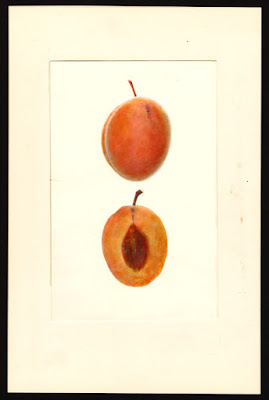Thanks to the Scion Exchange and my fellow fruit growing enthusiasts at the Home Orchard Society, some nice guys, I came home with several varieties that I wanted to graft as soon as I could.
Today was drizzling all day, not too bad for some grafting work, so I spent the afternoon in the home orchard grafting.
In general, I leave about 3 inches per scion, and try to make sure it has 3 buds, and the diameter matches the understock. I have not learned bark grafting and cleft grafting for large understock, which just seems to expose the tree to too much potential disease due to the large wound, but it does work for others. So, I look for low branches about the same size of the scion, and use those. For young trees that are still a small size, that seems to work very well for me.
What I grafted, today and yesterday:
1. To the injured, new, 4-way Euro plum, I added Yakima plum to a branch that appears to be off the understock, and Yellow Egg plum to replace the Italian plum branch. .
2. To my Stanley plum tree, I added Jefferson Plum. I have been unable to find info about that variety.
3. To the old green plum that came with the Battleground place, which might be a green gage plum, I added Yellow Egg and Yakima. I usually cut the scions into pieces with 2 buds, so one scion usually gives me a couple of grafts.
4. To the Rebecca's Gold pawpaw, I added grafts of Wilson pawpaw. Those were so delicate, and they have flower buds, and I'm not sure they have leaf buds, so who knows if they will take,
5. To the Illinois Everbearing mulberry, I added Noir de Spain mulberry, 2 grafts. The internode spaces were very long, so I made those as 1-bud grafts each. There is a bit if scion remaining, so might add more.
6. To one multigraft apple, I added Fameuse apple.
7. To other multigraft apples, I added Dolgo crabapple, Firecracker red flesh apple, and to Jonared, I added Jonathan, which I am curious to see if the redder sport is a sacrifice in flavor compared to the original.
8. Yesterday I also grafted scion from Fedco, Sweet-16 apple, King David Apple, and Opalescent. The first 2, I already grafted, but they had so little growth that I want to try again.
9. To an Asian pear tree, I added Chojuro.
10. To Aromatnaya quince, I added Crimea quince.
11. I added spare pieces of scion to the hawthorn thicket, Crimea quince and Chojuro Asian pear.
12. I also planted cuttings from Limon quince and Aromatnaya quince to see if they grow from Spring planted hardwood cuttings.
That's it for playing in the orchard, grafting. I did not cut myself - always a good thing. I know I don't "need" any more fruit varieties, but no harm in grafting on new varieties to see how they do and maybe get a taste in a couple of years. They may also help with pollination. I got to try my hand at grafting some species that I have not tried before - mulberry, pawpaw, quince. If any - or all - do poorly or are not good, I can always prune the bad ones off, without losing a tree. Ditto if one is way to vigorous and takes over a tree.
I'm using images from the USDA image collection. They are public domain. I don't know if the USDA will have funding cut and drop the collection, so it's nice to peruse them while there is a chance.


